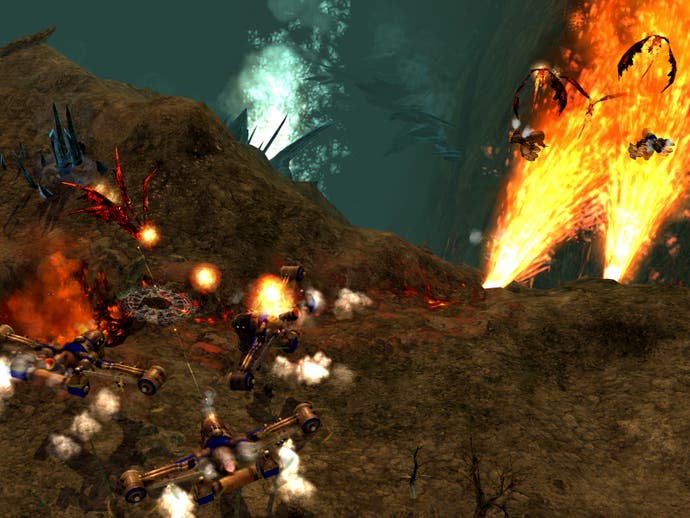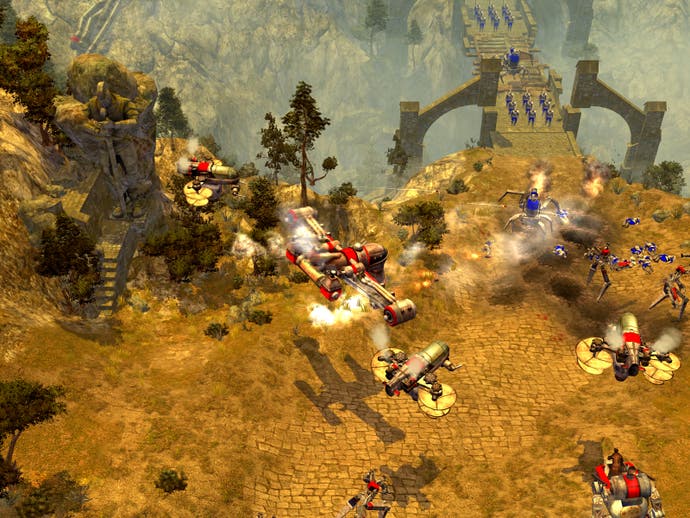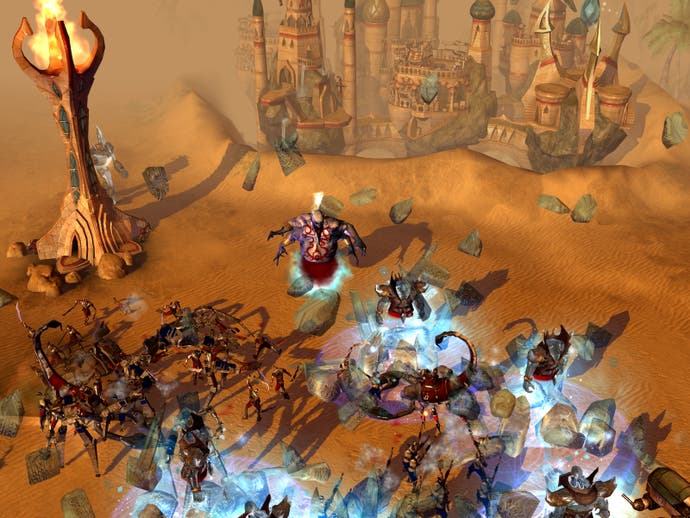Rise of Nations: Rise of Legends
Put your feet up. You know, rise of leg... oh, fuggetit.
Rise of Legends isn't the safe option for Big Huge Games. The predictable thing would have been to glue a "2" to the end of the original game's title and return to the scene of a previous real-time strategy triumph - to reaffirm brand qualities, or whatever marketing speak's popular in corporate boardrooms this week. But to their credit, Big Huge Games said screw that for a game of real-time soldiers and did something a little different.
Rise of Legends looked to be taking many of the key ideas of the original game and applying them to a very different milieu, creating a game that, while it had the same timbre as the original, promised to be impressively different. At least that's what we hoped when it was announced. Now we have some playable early code to compare and contrast those expectations with.
It's a fantasy game, but not the 'Stick Some Elf-Ears On That And It's Done' type. While it hits upon a few iconic fantastical images, it finds its own place and even a theme. The theme is Magic versus Technology. On one side, all the unconscious made magical flesh. On the other, the universal law of the universe; creation measured out with a slide-rule. It's the right side of the brain set at war with the left, man torn asunder in...
Ah, we're submitting to the right hemisphere there. That's unfair on the left. If there's a war, we have to at least pretend to be a neutral judge. There's only one way to play this fairly.
If you prefer the cold, hard, emotionless left lobe to the messier right, progress to section 1.
If you prefer the right lobe to the oh-GOD! you are so BORING! left, go to section 2.
SECTION 1
The preview code features one level for the campaign and access to the skirmish mode with two of the game's three sides - the remaining one will be revealed closer to the game's release - so we've been able to explore aspects of those. In the manner of the modern real-time strategy game, each features defined mechanics that separate it from the other.
To continue, go to section 3.
SECTION 2

There's an emotion related to games that people don't often talk about. It's when you find yourself with a new game before you and rather than excitement you think, "You know, can I really be arsed with this?" It's an urge that's often wrong. Those people commenting in the Top 50 who said, "None of these games excite me," have a terminal case of it. Get over that hump, and there could be a great game there. But it doesn't stop the hump being there.
Rise of Legends is a game in one of the PCs most overpopulated genres. If anything is going to be subject to the, "You know, can I really be arsed with this?", it's this. As it boots up and I start prodding around... well, that urge just isn't there. It's gut feeling. I like this and I haven't played it yet.
Which is surprising for a reason that we'll elaborate on during an embarrassing detour.
Go to section 4 if you want a confession.
Go to section 6 if you'd rather maintain some illusion of the writer's competence.
SECTION 3
The technological side is represented by The Vinci. The sketches of renaissance figure Leonardo Da Vinci influence the design of their forces. Their name appears to also be derived from him. The magical side are the Alim, with designs derived from middle-eastern fables like Arabian Nights.
They are contrasting forces. While both have an air capacity, the Alim gain flying units swiftly and have some extremely powerful units in that element. For example, their most powerful character is a Glass Dragon of some size. Conversely, the Vinci's best units are often ground-based. Specifically, there's a mechanical spider which is as large as a single city and would - were we more emotional - be an adversary you'd only approach with some trepidation. The Vinci also possess certain long-range artillery of considerable power. There are also considerable economic and production differences between them. In research, for example, the Alim receive points for building magus districts - a construction option unavailable to their opposition. Conversely, the Vinci must build freestanding research labs away from their cities, but can spend money upgrading each of these in its own individual way.
To continue, go to section 5.
SECTION 4
I hadn't played more than two minutes of Rise of Nations, which makes me some kind of bad person. Even fully patched up it crashed on my machine the very second any two armies started fighting. PC gaming, eh? In the day or so I spent trying to fix it, I played those first two minutes a half dozen time and the impression I took away from it was basically, "Christ. This is a bit slick, isn't it?" Even that brief experience added credence to how it's referred to by RTS experts as the Gold Standard in all these areas.
First impressions of actually starting to play Rise of Legends: "Christ. This is a bit slick, isn't it?"
Which is a good thing not to lose.
To get back to the main story go to section 6.
SECTION 5
There are two resources in the game. The mineral element "Timonium", and money. The former is gathered from mines. The latter is generated by caravans' progression between major settlements. The more merchant districts the city possesses, the greater the profit. By destroying a caravan, trade income can be removed. This would appear to be a tactical possibility for any gamer. There is also the possibility of trade with neutral settlements, another tactical element to consider. These can be brought under your control by military conquest or purchased outright. Conquest itself has also been expanded. Rather than simply reducing a structure's health to zero, if you have sufficient foot-soldiers in the vicinity you can "storm" it. The number of troops required varies depending on the defence of the structure, and goes down as its position becomes more logically untenable. The increasing RTS standard of "hero" units can also be purchased, offering more power and specialised talents over standard units. There's also the concept of "Dominances", with a limited-use special ability available to the first player to reach a certain threshold. For example, the first side to gain four foot-soldiers achieves Military Dominance, allowing you to convert opposing units to your cause. If your opponents then cross a higher threshold, this ability is wrested from you.
These are some of the additions to the Rise of Nations play set.
To continue, go to section 7.
SECTION 6

Oh God, are we behind the logical one already? I bet he's already onto talking about how much hard drive space the game takes to install or something. Er... what's next? Races. There's two of them. They seem pretty good! Oh yeah - heroes: The Vinci have people in big stompy walkers and the Alim have some hulking Djinn sorts. They seem pretty good too!
Yay for subjectivity. It's much easier work, especially at 3:40 am in the morning.
No sleep for the conceptualists.
Section 8 next! Quickly! Go!
SECTION 7
The graphics are highly acceptable for a 2006 release. They are attractive and well-animated, with many flattering details. While demanding on hardware in the current build, the code is in an early state and the accompanying literature stressed that it would be considerably optimised. That said, it was only a little slow on a medium-spec machine considerably beneath what they suggested as the minimum for the build. This may imply that despite the impressive visual details, those with more modest machines won't be left out.
To continue, go to section 10.
SECTION 8
While we're seeing similar technology here to Age of Empires III (physics, shininess, er... polygons?), at this stage it just looks a hell of a lot better. It's not just that it's a Fantasy Game - though being a fantasy game gives you a lot more room to show off in ways which a more realistic setting wouldn't - but a matter of art design. While you can applaud someone not just doing kobolds, you can do a cheap and nasty retro-tech or Arabian Knights look too. This isn't, but rather it's an integrated world. While the obvious showstoppers like the enormo-mechano-crabs or the dragons are going to be what draws attention in the screenshots, in play you'll be lingering on details like how the Alim cities form. As you add a district to a cities' central hub, the land smoothly falls away with the settlement floating gently in the ether. Completely naturalistic, completely naturalistic. The Vinci cities cling to the ground aggressively, each structure covered in whirring cogs, gears and all the assorted bits of Mechano you could never find a use for as a kid.
Games' aren't just about the screenshots, but motion. Rise of Legends appears to have been built with that in mind.
Go to 11. Do not collect £200.
SECTION 9
Ooh, you're a bad 'un. There's no link to this one. You're just reading it straight through. You dirty cheater. The divided hemisphere is disgusted with you.
You are dead. Go back to the beginning and start again.
SECTION 10
Even in its current state, the gameplayability is high.
To continue, go to section 12.
SECTION 11

I occasionally argue that playing videogames is a little like learning a language. It's about learning how to speak with the machine, in whatever dialect the developer constructed. Some dialects are similar. Videogame literacy is based around how many of these different dialects you've picked up. So, how many sorts of games you can communicate with on a basic level before learning individual games' quirks. Now, I'm fairly literate in the RTS, but the speed with which Rise of Legends teaches you its core concepts - even when you're at your most casual - is what gets it under your skin. If you try and purchase a district in one of your cities, it'll unobtrusively inform you that you could build an identical district - so gaining the same bonuses - in another city for less resources. What this actually does is properly introduce the concept that the more districts you add to any city, the more expensive each gets. And now that concept's introduced, you can ask yourself... well, is cheapest best or are there other considerations here?
It's a strategy game. You only really start to play a strategy game when you have a grasp of its core concepts and how to manipulate them. In this little snippet of play, Rise of Legends got me in admirably deep, admirably fast, and left me wanting more.
I mean, hell, one mission and a semi-functional skirmish mode? Hurry up and finish the game, you slackers! I want more. Yeah, unreasonable, I know. But I'm the right hemisphere. Unreasonable is what I do.
Section 13 now. Right now.
SECTION 12
It will be released in the first half of 2006. It will come in a box and be available through shops.
To reintegrate consciousness go to section 14.
SECTION 13
FIRST-HALF 2006! IT'S OUT IN THE FIRST HALF OF 2006! THAT'S SOON! HOW SOON? LATE SPRING? LATER? WHAT DOES THAT MEAN? OHMYMOTHERLOVINGGOD! I'M GOING TO MAKE A SPECIAL CALENDAR WITH BRIAN REYNOLDS' FACE ON AND KISS IT EVERY DAY!
To reintegrate consciousness go to section 14.
SECTION 14
And that's enough false dichotomies.
While Imagination versus Reason is a great theme for a videogame - hell, a great theme for anything - it's not a bright way to live. Anyone who tries to settle for one just limits their experience. Where Rise of Legends is interesting is that despite being about magic versus technology, it looks like being an avatar of both. As a piece of technology, it should be exquisite. As an example of the art of Western game design, it looks like it could be equally capable. Ideally, there should be no reason to leave any part of your brain at home. Which, ideally, is what games are all about.
I've got a headache now.

